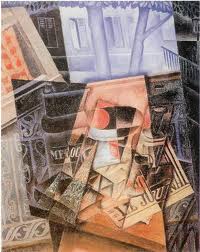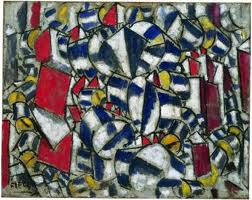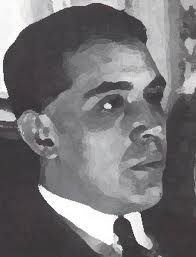Naturaleza muerta y paisaje - Place Ravignan
'Naturaleza muerta y paisaje - Place Ravignan' (Still-life Before an Open Window - Place Ravignan) is a Synthetic Cubist painting, produced by the Cubist painter, Juan Gris, originally from Spain, in 1915. This work is extremely colourful and free, which marked a change from some of Gris' earlier monochrome works.
The Painting

The painting 'Naturaleza muerta y paisaje - Place Ravignan' measures 1.16 metres by 0.89 metres and is an oil paint composition on a canvas background. The painting incorporates both elements of exterior and interior settings, but in two different styles.
The exterior, which can be seen from the open window, is painted a more traditional, Renaissance perspective. From the window we can see accurately drawn buildings, complete with windows and shutters, the railings on the street corner, a street light, and a tree, whose canopy stretches across the top of the painting.
The outside section is painted in a cool blue colour which makes the scene outside appear almost dream-like, coupled with the element of nature in the tree, softens the harsh angles that can be found in the buildings outside. The railings that surrounded the window help link the two sections of the painting together.
The interior section of the painting is a completely different story. It contrasts with the exterior part of the painting in several ways. One of the most notable differences is the use of colour. The objects that can be found inside are painted in bright and varying colours which helps make them stand out in comparison to the blue of the exterior section above and behind. The table on which the objects are lying is painted with great detail in order to create a wood grain effect.

The objects on the table, which include some glasses, a bottle of wine, a newspaper, a book and a compote, all blend into one another through the use of Juan Gris' Cubist Collage style. These shafts or sections are probably the representation of the way the light is falling on the objects. The newspaper's title, 'Le Journal', is elongated so that the letter 'u' is created by one of the other objects. According to art critics, this represents the flexibility of images and signs in the painting.
'Naturaleza muerta y paisaje - Place Ravignan' is a triumph of Gris' own Cubist style and it shows his excellent ability to create complex compositions with simple objects and ideas. In this painting, Juan Gris manages to join the binary oppositions of day and night, still-life painting and landscape painting, inside and outside.
History

At the time of painting 'Naturaleza muerta y paisaje - Place Ravignan', Juan Gris has been considered to be at the height of his career. This is shown in his expert balance of geometry and artistic flair in this painting. Gris had moved on from copying the styles of the founders of Cubism, Pablo Picasso and Georges Braques, and had discovered his own unique style. He also realised that the objects he painted were no longer just subjects but could be used to experiment with collage and perspective.
'Place Ravignan' in the title refers to the street where Juan Gris was living in Paris at the time of painting this piece. Therefore the subject of the painting is most likely to be Juan Gris' own view from his window, and his objects upon the table.
The painting has changed owners many times in its lifespan. It was once owned by Pierre Faure, who bought it to be part of his collection of twenty-six Gris paintings between 1915 and 1927. Later it was sold and lent to be put on display in various galleries. Today it can be found in the Philadelphia Museum of Art, as part of the Louise and Walter Arensberg Collection, where it has been from the year of 1950.
